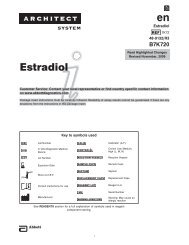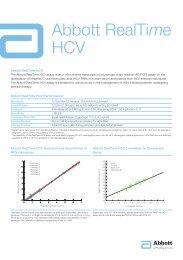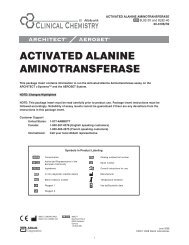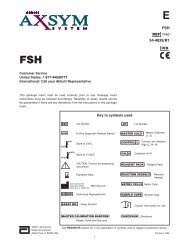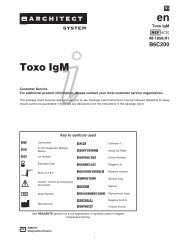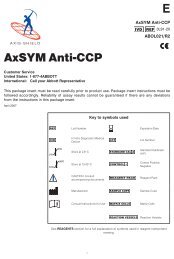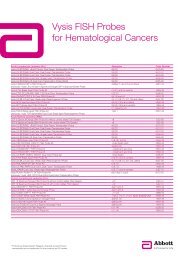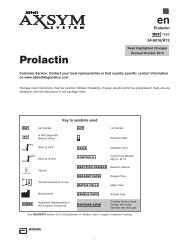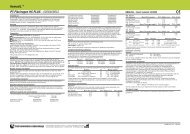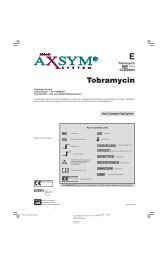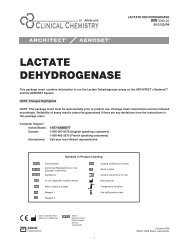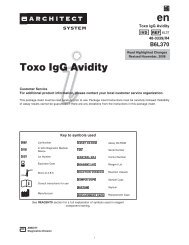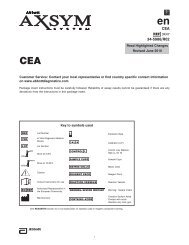ABBOTT PRISM® HTLV-I/HTLV-II - ILEX Medical Systems
ABBOTT PRISM® HTLV-I/HTLV-II - ILEX Medical Systems
ABBOTT PRISM® HTLV-I/HTLV-II - ILEX Medical Systems
Create successful ePaper yourself
Turn your PDF publications into a flip-book with our unique Google optimized e-Paper software.
RESULTS<br />
Calculation of Cutoff and S/CO Values<br />
The <strong>ABBOTT</strong> PRISM System calculates the <strong>ABBOTT</strong> PRISM <strong>HTLV</strong>-I/<strong>HTLV</strong>-<strong>II</strong><br />
assay cutoff value using the following formula:<br />
Cutoff = Mean Negative Calibrator Net Counts<br />
+ (0.15 x Mean Positive Calibrator Net Counts)*<br />
Example: If the Mean NCC = 1,100, and the Mean PCC = 6,900,<br />
1,100 + (0.15 x 6,900) = 2,135<br />
Cutoff = 2,135<br />
* The Positive Calibrator, <strong>HTLV</strong>-<strong>II</strong> Positive Assay Control (1), and Negative<br />
Calibrator Mean Net Counts are calculated using the two lowest replicates. An<br />
Instrument Code (02-211) will be displayed in place of the count value for the<br />
third replicate. Each of the two remaining replicates of the Positive Calibrator<br />
and the Negative Calibrator used to calculate the cutoff must meet all<br />
specifications.<br />
The <strong>ABBOTT</strong> PRISM System calculates the <strong>ABBOTT</strong> PRISM <strong>HTLV</strong>-I/<strong>HTLV</strong>-<strong>II</strong> assay<br />
S/CO using the following formula:<br />
S/CO = Sample Net Counts ÷ Cutoff<br />
Example: If the Sample Net Counts = 3,000, and the Cutoff = 2,135,<br />
3,000 ÷ 2,135 = 1.41<br />
S/CO = 1.41<br />
INTERPRETATION OF RESULTS<br />
In the <strong>ABBOTT</strong> PRISM <strong>HTLV</strong>-I/<strong>HTLV</strong>-<strong>II</strong> assay, specimens with Net Counts less<br />
than the cutoff value are considered nonreactive and need not be tested further.<br />
Specimens with Net Counts greater than or equal to the cutoff value are considered<br />
initially reactive. All specimens that are reactive on initial testing must be centrifuged<br />
according to the table in the Specimen Collection and Preparation for Analysis<br />
section of this package insert and retested in duplicate.<br />
NOTE: If re-testing a specimen within 24 hours of the initial centrifugation, the<br />
specimen is not required to be re-centrifuged.<br />
If repeat testing shows the Net Counts for both retests to be less than the cutoff<br />
value, the specimen is nonreactive. If the Net Counts of either retest are greater<br />
than or equal to the cutoff value, the specimen is repeatedly reactive. Repeatedly<br />
reactive specimens should be investigated further by supplemental tests such as<br />
immunoblots, immunoprecipitation or immunofluorescent assays.<br />
<strong>ABBOTT</strong> PRISM reports display sample results in Net Counts and/or S/CO. Net<br />
Counts are used by <strong>ABBOTT</strong> PRISM to interpret results. The S/CO value is provided<br />
in reports to show relative reactivity to the cutoff value. In the <strong>ABBOTT</strong> PRISM<br />
<strong>HTLV</strong>-I/<strong>HTLV</strong>-<strong>II</strong> assay, specimens with S/CO values of less than 1.00 are considered<br />
nonreactive. Specimens with an S/CO value of greater than or equal to 1.00 are<br />
considered reactive.<br />
For details on configuring the <strong>ABBOTT</strong> PRISM System to use Grayzone<br />
Interpretations, refer to the <strong>ABBOTT</strong> PRISM Operations Manual, Section 2.<br />
READING RESULTS<br />
Some S/CO values may be flagged with "" symbols. Refer to the <strong>ABBOTT</strong><br />
PRISM Operations Manual, Section 5.<br />
SYSTEM ERRORS<br />
For a description of the error codes that appear in the <strong>ABBOTT</strong> PRISM Report,<br />
refer to the <strong>ABBOTT</strong> PRISM Operations Manual, Section 10.<br />
LIMITATIONS OF THE PROCEDURE<br />
• Testing of previously frozen samples with the <strong>ABBOTT</strong> PRISM <strong>HTLV</strong>-I/<strong>HTLV</strong>-<strong>II</strong><br />
assay may cause an increase in non-specific reactivity.<br />
• The <strong>ABBOTT</strong> PRISM <strong>HTLV</strong>-I/<strong>HTLV</strong>-<strong>II</strong> assay does not discriminate between<br />
<strong>HTLV</strong>-I and <strong>HTLV</strong>-<strong>II</strong> antibody reactivity.<br />
• This assay was designed and validated for use with human serum or plasma<br />
from individual patient and donor specimens. Pooled specimens must not be<br />
used since the accuracy of their test results has not been validated.<br />
• It is recommended that repeatedly reactive specimens be investigated by<br />
supplemental testing. Individuals who are repeatedly reactive should be referred<br />
for medical evaluation which may include additional testing.<br />
• False reactive results can be expected with any test kit. Falsely elevated results<br />
have been observed due to non-specific interactions (see Table <strong>II</strong>).<br />
• Performance has not been established for body fluids other than serum or<br />
plasma.<br />
• Previously frozen specimens must be centrifuged per the Specimen Collection<br />
and Preparation for Analysis section of this package insert prior to running the<br />
assay.<br />
• Serum from heparinized patients may be incompletely coagulated. Erroneous<br />
or inconsistent results may occur due to the presence of fibrin. To prevent this<br />
phenomenon, draw specimen prior to heparin therapy.<br />
• The use of specimens with obvious microbial contamination should be avoided.<br />
• Although the association of infectivity and the presence of anti-<strong>HTLV</strong>-I/<strong>HTLV</strong>-<strong>II</strong><br />
is strong, it is recognized that presently available methods for<br />
anti-<strong>HTLV</strong>-I/<strong>HTLV</strong>-<strong>II</strong> detection are not sensitive enough to detect all potentially<br />
infectious units of blood or possible cases of <strong>HTLV</strong>-I/<strong>HTLV</strong>-<strong>II</strong> infection.<br />
6<br />
• The interpretation of results of specimens found repeatedly reactive by the<br />
<strong>ABBOTT</strong> PRISM <strong>HTLV</strong>-I/<strong>HTLV</strong>-<strong>II</strong> assay and negative or indeterminate on<br />
additional supplemental testing is unclear. Further clarification may be obtained<br />
by testing another specimen from the same patient taken 3 to 6 months later.<br />
EXPECTED RESULTS<br />
In a random population of 6,678 volunteer blood donor specimens, four (0.06%)<br />
were reactive by the <strong>ABBOTT</strong> PRISM <strong>HTLV</strong>-I/<strong>HTLV</strong>-<strong>II</strong> assay. Among 148<br />
preselected anti-<strong>HTLV</strong>-I positive and 148 preselected anti-<strong>HTLV</strong>-<strong>II</strong> positive<br />
specimens, the <strong>ABBOTT</strong> PRISM <strong>HTLV</strong>-I/<strong>HTLV</strong>-<strong>II</strong> assay detected 100.00% as<br />
repeatedly reactive.<br />
SPECIFIC PERFORMANCE CHARACTERISTICS<br />
Precision<br />
Assay reproducibility was determined by assaying a 28 member panel consisting<br />
of four replicates each of three diluted specimens reactive for anti-<strong>HTLV</strong>-I (panel<br />
members 1, 2, and 3), three diluted specimens reactive for anti-<strong>HTLV</strong>-<strong>II</strong> (panel<br />
members 4, 5, and 6) and one specimen nonreactive for anti-<strong>HTLV</strong>-I or anti-<strong>HTLV</strong>-<strong>II</strong><br />
(panel member 7). The panel was tested in five runs over five days with each of<br />
three master lots at a total of three sites.<br />
The intra- and inter-run standard deviation (SD) and percent coefficient of variation<br />
(%CV) were analyzed with a variance components analysis, using a nested analysis<br />
of variance model67 (Table I).<br />
Mean S/CO is defined as the mean sample net counts (NET) divided by the<br />
calculated Cutoff.<br />
TABLE I<br />
<strong>ABBOTT</strong> PRISM <strong>HTLV</strong>-I/<strong>HTLV</strong>-<strong>II</strong><br />
Assay Reproducibility<br />
Number of Mean Intra-run Inter-run*<br />
Panel Member Replicates S/CO SD %CV SD %CV<br />
1 120 8.27 0.339 4.1 0.487 5.9<br />
2 118 5.19 0.240 4.6 0.291 5.6<br />
3 114 3.17 0.131 4.1 0.190 6.0<br />
4 119 6.90 0.291 4.2 0.446 6.5<br />
5 120 3.98 0.180 4.5 0.254 6.4<br />
6 119 2.35 0.096 4.1 0.138 5.9<br />
7 120 0.56 0.026 4.7 0.033 5.9<br />
Negative Control 240 0.42 0.031 7.3 0.035 8.3<br />
Positive Control 178 2.02 0.114 5.7 0.142 7.0<br />
Supplemental<br />
Positive Control<br />
240 1.84 0.097 5.3 0.115 6.3<br />
Number of Mean Intra-run Inter-run*<br />
Calibrators Replicates NET SD %CV SD %CV<br />
Negative 180 833 50.1 6.0 82.8 9.9<br />
Positive 179 7,208 292.6 4.1 485.6 6.7<br />
Supplemental<br />
Positive<br />
180 6,179 273.5 4.4 438.2 7.1<br />
* This term includes intra-run variability.<br />
Specificity<br />
The specificity of the <strong>ABBOTT</strong> PRISM <strong>HTLV</strong>-I/<strong>HTLV</strong>-<strong>II</strong> assay was estimated<br />
assuming a zero prevalence of <strong>HTLV</strong>-I and/or <strong>HTLV</strong>-<strong>II</strong> in volunteer blood donors<br />
and plasmapheresis donors.<br />
A total of 6,678 serum and plasma specimens from volunteer blood donors and<br />
plasmapheresis donors was collected from four blood centers (Table <strong>II</strong>). Of the<br />
four repeatedly reactive specimens one was excluded as confirmed positive by<br />
DBL <strong>HTLV</strong>-I/<strong>II</strong> Western Blot, RIPA-I, and/or RIPA-<strong>II</strong>. a Therefore, of the 6,677<br />
donations presumed seronegative for anti-<strong>HTLV</strong>-I and anti-<strong>HTLV</strong>-<strong>II</strong>, <strong>ABBOTT</strong><br />
PRISM <strong>HTLV</strong>-I/<strong>HTLV</strong>-<strong>II</strong> had an estimated specificity of 99.96% (6,674/6,677) with<br />
a 95% confidence interval of 99.87% to 99.99%.<br />
Specimens from individuals with medical conditions unrelated to <strong>HTLV</strong>-I and/or<br />
<strong>HTLV</strong>-<strong>II</strong> infection or containing potentially interfering substances and specimens<br />
from random hospital patients were tested with the <strong>ABBOTT</strong> PRISM <strong>HTLV</strong>-I/<strong>HTLV</strong>-<strong>II</strong><br />
assay (Table <strong>II</strong>).<br />
a A confirmed positive result was defined by the presence of antibodies to two gene<br />
products (gag p24 and env gp46 or gp61/67) using Western Blot and/or RIPA.



